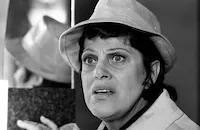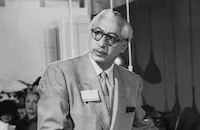Which Way to the Front?

Brief Synopsis
Cast & Crew
Jerry Lewis
Jerry Lewis
Jan Murray
Willie Davis
John Wood
Steve Franken
Film Details
Technical Specs

Synopsis
Brendan Byers III is a patriotic millionaire who, after being rejected in 1943 by the United States Army as physically unfit, forms his own militia to end the stalemated war in Italy. Brendan and three other draft rejects sail to Italy in Brendan's yacht and kidnap German Field Marshal Kesselring. Disguised as Kesselring, Brendan orders a wide-scale German retreat but then finds himself involved in the "Generals' Plot" to assassinate Hitler. When Brendan is captured by the Allied forces, he is unable to convince his captors that he is an American. Finally, he bribes a guard and escapes with his cronies, who immediately head for Japan to continue their war effort.

Director

Jerry Lewis
Cast

Jerry Lewis
Jan Murray
Willie Davis

John Wood
Steve Franken
Dack Rambo
Paul Winchell
Sidney Miller

Robert Middleton

Kaye Ballard

Harold J. Stone
Joe Besser

Gary Crosby
Artie Lewis
Mickey Manners
Danny Dayton

Kathleen Freeman

Neil Hamilton
Milton Frome
Bob Lauher
Bobo Lewis
George Takei
Martin Kosleck

Fritz Feld
Ronald Lewis

Benny Rubin

William Wellman Jr.
Crew
Bernard Abramson
John Beckman
Hal Bell
Louis Y. Brown
Sonny Burke
Dick Butz
Dee Caruso
Dee Caruso
Robert Cooper
Gerald Gardner
Gerald Gardner
Arthur Gerstle
Bob Grimm
Hazel Hall
Bob Harvey
George Hause
Ralph S. Hurst
Richard Johnson
W. Wallace Kelley
Will C. King
Jerry Lewis
Gene Liggett
Carl Manoogian
Kyme Meade
Richard Miller
Tye Oswald
Al Overton Sr.
Don Record
Frank Regula
Mike Romersa
Richard M. Rubin
Russ Saunders
Joe E. Stabile
Robert Steinhauer
Jack Stone
Guy Verhille
Dick Walters
Ralph Webb
Russel Wiles
Fred Williams
Lee Wilson

Videos
Movie Clip



Film Details
Technical Specs

Articles
Which Way to the Front?
Which Way to the Front was written by Gerald Gardner and David Caruso and contains enough stupid gags to keep a talented cast of comedians coasting on fumes regardless of whether the story makes any sense at all and a talented cast is exactly what Jerry Lewis assembled. First, a little background on the story.
The movie opens in 1943 with Brendan Byers III (Jerry Lewis), the richest man in the world, sulking about his office as his right-hand man, Finkel (John Wood), tries to come up with things Byers can do since Byers is bored because he has done everything, or so he claims. Finkel suggests the army because as luck would have it, Byers' draft notice just came in the mail. Since Byers has never served in the army before it seems like the perfect thing to get him out of his rut. Besides, he gets to serve his country in the fight against the worldwide evil of Nazism. The problem is, when he shows up for his physical, he's classified as 4F. When another draftee in the same situation asks what that means, fellow 4Fer Sid Hackle (Jan Murray) replies, "It means they won't call us unless Hitler gets to Connecticut." Byers doesn't take the rejection well and determines to use his money and power to get the other 4Fers to join him as members of a crack commando team that he will build and train, with the help of hired professionals, of course. As each man is desperate to escape from their lives, they agree. As an added incentive, if they stick it out, Byers has a check for $100,000 with each man's name on it waiting when they return.
The fact that they even get to Germany, on Byers yacht no less, is miracle enough but once they arrive, they put into operation a plan that must get a top Nazi Field Marshall, Erik Kesselring (also Lewis), out of position and Byers, in disguise, into his position so Byers can botch the Nazi's plans in Italy and break a stalemate that will help the Allies advance. If this sounds like a ridiculous situation, it is. If it sounds like a slightly different take on The Great Dictator, well, it's not. Sure, there's the lookalike plot and the ridiculing of Hitler but the tone of the film exists on a level so utterly reckless, slapdash, and zany, that any other comparison to The Great Dictator flies through the window before the sash has even had a chance to be thrown out. In other words, it's a Jerry Lewis movie.
The thing about Which Way to the Front is that it has all the ludicrous elements and dumb gags that Lewis fans are accustomed to but with a limited budget and a truncated shooting time that left Lewis with little option for retakes and extensive editing, most of the Lewis directorial touch is absent. Fortunately, he does have a stellar cast.
Jan Murray, the great Borscht Belt comic, probably does the best job in the movie, handling his role as straight man to Lewis while also being given plenty of leeway to use his own deadpan delivery for laughs all his own. In fact, this has to be one of the most generous Jerry Lewis movies ever as each cast member is given a chance to be the center of attention more than once. Sidney Miller shines in his role as he plays Adolph Hitler so zanily over the top that even The Producers Dick Shawn might think he'd gone too far (that's a compliment). Other standouts include the great Kaye Ballard, Steve Franken, and John Wood. Even former Los Angeles Dodgers' centerfielder Willie Davis does a pretty good job, given that he's surrounded by seasoned comics. There's also a brief appearance by a post Star Trek George Takei in a minor role.
Two other things stand out about the film. One, it has one of the longest pre-credit sequences in movie history (though not the longest by several minutes), with the opening credits not beginning until a full nineteen minutes into the movie. Two, it takes a budgetary necessity and turns it into a stylistic decision. Lewis had a choice: try his best to make a period piece with almost no budget or announce loudly and clearly that the movie was utterly divorced from reality by making no attempt to change anything - clothing styles, hairstyles, technology, design, etc. - from 1970 and just say the story takes place in 1943, almost as a dare to the audience to accept it.
The film did poorly in the states but better overseas. Nonetheless, it wasn't the success Lewis hoped for and two years later he attempted a second World War II film, this time with a more serious undertone, The Day the Clown Cried but it went unreleased. It would be until 1980 before Lewis directed another feature. And he would never have a cast as seasoned and expert again.
By Greg Ferrara

Which Way to the Front?
Quotes
Trivia
Notes
Newsreel footage from World War II is included.

Miscellaneous Notes
Released in United States 1970
Released in United States on Video July 18, 1990
Released in United States 1970
Released in United States on Video July 18, 1990













